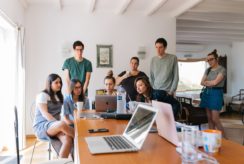The health and economic crisis acted as a catalyst in numerous areas by forcing companies to be resilient. Over the last 6 months, we gathered and analyzed our clients and experts’ testimonies to understand the post COVID- workplace characteristics in terms of layouts and its consequences on employees, management, work’s organization and models.
Health of employees and work environment: a sustainable challenge of health resilience
Employee’s health is a central topic of unions management teams since the beginning of the COVID-19 crisis: re-organizing the company by considering the sanitary security and health of employees implies being able to adapt and design new norms of onsite working. Indisputably, the protective measures, social distancing, no contacts… are new measures that will change the employees’ ways of working on the long term.
In this context, some companies questioned the open space format, by showing that these layouts no longer work given current Covid requirements: 9% of companies have, as a target, objectives to challenge flex-office and 18% wish to question the use of open spaces (JLL study).
We believe, the solution resides more in the ‘smart building’ solutions. If the technological solutions in this area were oriented essentially through green facility management, it would guarantee optimized and ‘resilient’ workplaces from a health point of view (equipped with sensors to better understand the employees’ circulation and socialization patterns and optimize flows, artificial intelligence and data science supporting any collective infection, connected technologies allowing the ‘no contact’ mode with more distant, vocal and gesture controlling in the workplace…!).
Hybrid ways of working and ‘meaning’ in the workplace
Beyond health concerns, the work environment must adapt to news ways of functioning created by the extended remote working, which is today at the core of most companies, thinking about adapting their remote working agreements (82% of HRD think that a durable development of remote working is advisable, according to a Deskeo survey– “Coronavirus et télétravail”). The ‘hybrid’ workspace between remote or third places working and the company- that companies must face today because of the health crisis and temporary remote working measures- will become a reality for a long time.
The term of workspace is today confused with the daily life. The idea of an attributed desk from Monday to Friday is now over and the physical workspace, the ‘office’ as qualified before is becoming a relative term and a challenged attractive feature.
If quarantine and the transitory period which has followed, the reintroduction of (current) lockdown measures are pushing companies and individuals to adapt their ways of working and adopt new tools and digitals use to overcome the physical distance, it is however certain that remote working revealed needs that digitalization can’t properly answer. Therefore, it is a necessity to think about the ways of working and give a new meaning to the ‘office’ to answer a core question: what can we expect from our workspaces that remote working can’t offer? Why should we go to the office from now on? We must look towards finding a new meaning for the office and to bring employees together in a positive way in the workplace.
The office of tomorrow: yes but why?
Since the first quarantine, collaboration and digital aspects are now working in pairs, that’s for sure. The great majority of companies employ tried and tested solutions to collectively work and share (Microsoft Teams, Zoom..). 71% of employees declare that their company has put in place collaborative tools to ease remote working, and this was a novelty for 12% of them. (BNP Paribas Real Estate x IFOP study – « Les français à l’épreuve du confinement Vague 2 »).
However, studies show that continuous, easy and seamless connectivity with their team or his/her ‘professional community’ is far more important than the shared space. This is where the office still has a position and challenges remote working. Employees need their peers and the collective experience will be more ‘emotionally’ strong if done onsite.
A comprehensive review of both collective and individual ways of functioning is needed. Studies are today performed in some companies to qualify those ways of working and organize the teams around hybrid ways of working and 2 simple axes:
- Keep the ‘individual productivity’, implying concentration and limited interaction with other employees to remote working days.
- Identify the situations where being together is positive, such as brainstorming, sharing of experience, collective intelligence, co-construction and innovation and informal discussion to organize them onsite.
A study reveals that 53% of decision makers (HRs, real estate, managers) evaluate that 5 years from now, offices will act as collaborative spaces and won’t be visited on a daily basis. (Switch / Bureau à partager survey).
Therefore, the office, which was perceived as a ‘refuge’ place and unavoidable, will have to mutate into a ‘reference’ place for the professional community, especially to maintain the social link, which is a strong engagement factor and talent retention. 88% of managers fear the sense of belonging and engagement with extended remote working will be harmed. ANDRH x BCG survey – « Le futur du travail vu par les DRH »).
A question of methods
The used method remains the challenge. Indeed, this analysis must be co-constructed with the teams, guided by the management team to collectively land on new ways of functioning and new rules which will give sense to ‘being together’. A first pillar of the new collective ways of working is to make at least one day on site a common theme where the whole team is united, for rewarding activities. Each team will then have to invent their own ways of functioning, which will give a new sense to the office and workspaces.
Define your ways of working of tomorrow to consider your working environments and the new "sense of the office"
This article was written with the contribution of Sibylle Delaboulaye and Gaëlle Larche, respectively manager and senior manager of the People & Change practice at Wavestone.




